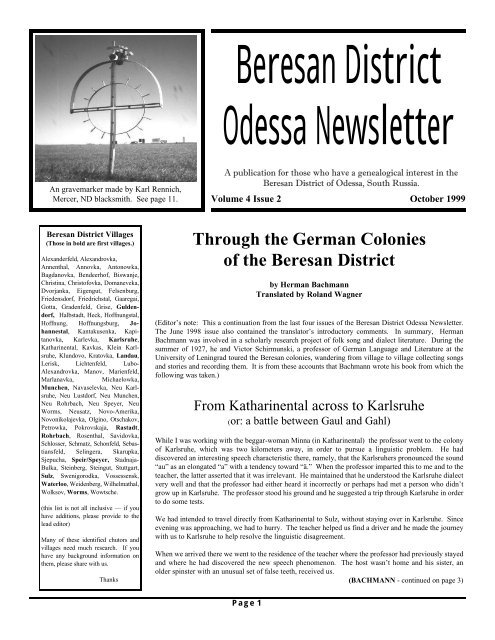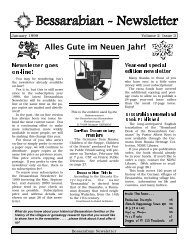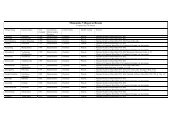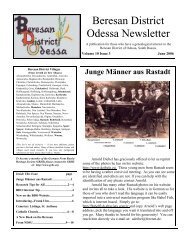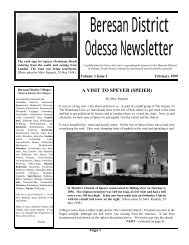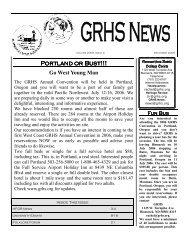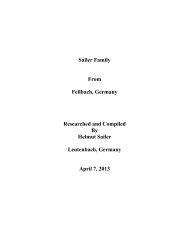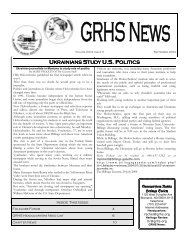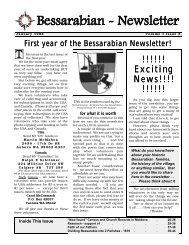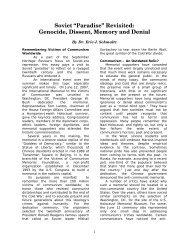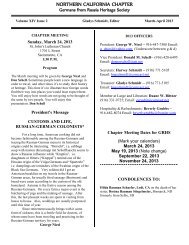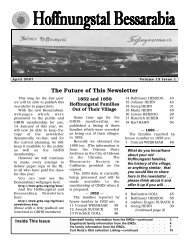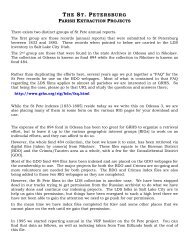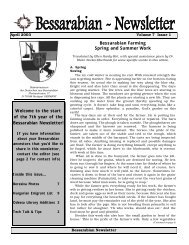Beresan District Odessa Newsletter - GRHS
Beresan District Odessa Newsletter - GRHS
Beresan District Odessa Newsletter - GRHS
You also want an ePaper? Increase the reach of your titles
YUMPU automatically turns print PDFs into web optimized ePapers that Google loves.
An gravemarker made by Karl Rennich,<br />
Mercer, ND blacksmith. See page 11.<br />
<strong>Beresan</strong> <strong>District</strong> Villages<br />
(Those in bold are first villages.)<br />
Alexanderfeld, Alexandrovka,<br />
Annenthal, Annovka, Antonowka,<br />
Bagdanovka, Bendeerhof, Biswanje,<br />
Christina, Christofovka, Domaneveka,<br />
Dvorjanka, Eigengut, Felsenburg,<br />
Friedensdorf, Friedrichstal, Gaaregai,<br />
Gotta, Gradenfeld, Grise, Guldendorf,<br />
Halbstadt, Heck, Hoffnungstal,<br />
Hoffnung, Hoffnungsburg, Johannestal,<br />
Kantakusenka, Kapitanovka,<br />
Karlevka, Karlsruhe,<br />
Katharinental, Kavkas, Klein Karlsruhe,<br />
Klundovo, Kratovka, Landau,<br />
Lerisk, Lichtenfeld, Lubo-<br />
Alexandrovka, Manov, Marienfeld,<br />
Marlanavka, Michaelowka,<br />
Munchen, Navaselevka, Neu Karlsruhe,<br />
Neu Lustdorf, Neu Munchen,<br />
Neu Rohrbach, Neu Speyer, Neu<br />
Worms, Neusatz, Novo-Amerika,<br />
Novonikolajevka, Olgino, Otschakov,<br />
Petrowka, Pokrovskaja, Rastadt,<br />
Rohrbach, Rosenthal, Savidovka,<br />
Schlosser, Schmatz, Schonfeld, Sebastiansfeld,<br />
Selingera, Skarupka,<br />
Sjepucha, Speir/Speyer, Stadnaja-<br />
Bulka, Steinberg, Steingut, Stuttgart,<br />
Sulz, Swenigorodka, Vossessensk,<br />
Waterloo, Weidenberg, Wilhelmathal,<br />
Wolksov, Worms, Wowtsche.<br />
(this list is not all inclusive — if you<br />
have additions, please provide to the<br />
lead editor)<br />
Many of these identified chutors and<br />
villages need much research. If you<br />
have any background information on<br />
them, please share with us.<br />
Thanks<br />
<strong>Beresan</strong> <strong>District</strong><br />
<strong>Odessa</strong> <strong>Newsletter</strong><br />
A publication for those who have a genealogical interest in the<br />
<strong>Beresan</strong> <strong>District</strong> of <strong>Odessa</strong>, South Russia.<br />
Volume 4 Issue 2 October 1999<br />
Through the German Colonies<br />
of the <strong>Beresan</strong> <strong>District</strong><br />
Page 1<br />
by Herman Bachmann<br />
Translated by Roland Wagner<br />
(Editor’s note: This a continuation from the last four issues of the <strong>Beresan</strong> <strong>District</strong> <strong>Odessa</strong> <strong>Newsletter</strong>.<br />
The June 1998 issue also contained the translator’s introductory comments. In summary, Herman<br />
Bachmann was involved in a scholarly research project of folk song and dialect literature. During the<br />
summer of 1927, he and Victor Schirmunski, a professor of German Language and Literature at the<br />
University of Leningrad toured the <strong>Beresan</strong> colonies, wandering from village to village collecting songs<br />
and stories and recording them. It is from these accounts that Bachmann wrote his book from which the<br />
following was taken.)<br />
From Katharinental across to Karlsruhe<br />
(or: a battle between Gaul and Gahl)<br />
While I was working with the beggar-woman Minna (in Katharinental) the professor went to the colony<br />
of Karlsruhe, which was two kilometers away, in order to pursue a linguistic problem. He had<br />
discovered an interesting speech characteristic there, namely, that the Karlsruhers pronounced the sound<br />
“au” as an elongated “a” with a tendency toward “ä.” When the professor imparted this to me and to the<br />
teacher, the latter asserted that it was irrelevant. He maintained that he understood the Karlsruhe dialect<br />
very well and that the professor had either heard it incorrectly or perhaps had met a person who didn’t<br />
grow up in Karlsruhe. The professor stood his ground and he suggested a trip through Karlsruhe in order<br />
to do some tests.<br />
We had intended to travel directly from Katharinental to Sulz, without staying over in Karlsruhe. Since<br />
evening was approaching, we had to hurry. The teacher helped us find a driver and he made the journey<br />
with us to Karlsruhe to help resolve the linguistic disagreement.<br />
When we arrived there we went to the residence of the teacher where the professor had previously stayed<br />
and where he had discovered the new speech phenomenon. The host wasn’t home and his sister, an<br />
older spinster with an unusual set of false teeth, received us.<br />
(BACHMANN - continued on page 3)
<strong>Newsletter</strong> Line-up<br />
Lead Editor Merv Rennich / R060<br />
Assistant Editor Carol McCormack /M150<br />
Assistant Editor Roland Wagner / W011<br />
Assistant Editor Dale Lee Wahl / W078<br />
Subscriptions Arletta Baskins / B115<br />
Archives:<br />
Maps Jeff Hatzenbeller<br />
Village Coordinators:<br />
Felsenburg George Hoff / H072<br />
Guldendorf Curt Renz / R022<br />
Johannestal Carol Fuchs / F061<br />
Johannestal Ray Heinle<br />
Landau Diane Wandler / W090<br />
Landau Zita Gieser<br />
Neu Lustdorf Elsie Heuther / H008<br />
Neusatz Ken Aisenbrey / A013<br />
Rastadt Diane Wandler / W090<br />
Rastadt Letty Schoch / S193<br />
Rohrbach Arletta Baskins / B115<br />
Rohrbach Rosemarie Dinkel / D022<br />
Rohrbach Nancy Schroeder<br />
Rohrbach Ed Schulz / S043<br />
Rohrbach Lucy Simpson / S046<br />
Speier Albert Berger<br />
Speier Valerie Ingram / I009<br />
Sulz Albert Berger<br />
Sulz Valerie Ingram / I009<br />
Waterloo Betty Rennich / R103<br />
Waterloo Lucy Simpson / S046<br />
Weidenberg Richard m Heli<br />
Worms Arletta Baskins / B115<br />
Worms Mary-Lynne Harding/H187<br />
Worms Nancy Schroeder<br />
Worms Ed Schulz / S043<br />
Worms Lucy Simpson / S046<br />
Worms Dale Lee Wahl / W078<br />
(The addresses for most of the Editors and most<br />
of the Village Coordinators can be found in the<br />
latest issue of the <strong>GRHS</strong> Der Stammbaum.)<br />
“It is a<br />
revered thing<br />
to see an ancient<br />
castle not in decay,<br />
But how much more it is<br />
to behold an ancient family<br />
which has stood against the waves<br />
and weathers of time.”<br />
- Francis Bacon<br />
<strong>Beresan</strong> <strong>District</strong> <strong>Odessa</strong> <strong>Newsletter</strong> - Volume 4 Issue 2: October 1999<br />
� LETTERS<br />
Wilma Heckenlaible Spice<br />
Pittsburg, PA<br />
I have been following with great interest the series from Herman Bachmann’s<br />
book, “Through the German Colonies of the <strong>Beresan</strong> <strong>District</strong>.” He is such a good<br />
writer and his report makes such entertaining reading! And I was thrilled a while<br />
back when my grandfather’s village of Waterloo was described! I look forward to<br />
the coming episodes.<br />
Is this book available for purchase somewhere? I tried Amazon.com and Mail<br />
Order Kaiser, with no success. I assume the the SONGS are reproduced in the<br />
original book: (I hope) I would love to have them!<br />
If this book is not in print, perhaps it should be. I suppose by now the original<br />
copyright has expired, though Roland Wagner’s TRANSLATION surely must still<br />
be under copyright.<br />
Thanks for the wonderful job everyone is doing with the BDO <strong>Newsletter</strong>!<br />
Reply from Roland Wagner:<br />
Thanks for the comments on my translation of Herman Bachmann’s book, which<br />
has been appearing in the BDO <strong>Newsletter</strong>. Wilma, concerning your question<br />
about where I found the book, it was published by the Landsmannschaft der<br />
Deutschen aus Russland in Stuttgart in 1974, and I assume it has long been out of<br />
print. I found a copy about 10 years ago in Lincoln at the AHSGR library.<br />
Bachmann originally published this material in German magazines in Russia in<br />
the 1920s, and it was long out of print until the Landsmannschaft collected it in<br />
1974. In addition to the travelogue, he also wrote a series of dialect tales about<br />
everyday life in the colonies, called “Kolonischtageschichtla.”<br />
I have spoken with Michael Miller who has expressed an interest in publishing<br />
both translations (the travelogue and the tales) in book form through the GRHC at<br />
Fargo. I told him that they could hold the copyright and use any funds generated<br />
to further their activities.<br />
Roland<br />
Cindy Goldsworthy<br />
Page 2<br />
�����<br />
I came across this letter written on Jan 1, 1922 in Karlsruhe by a John Renner to<br />
his Uncle Joseph Renner in America. The letter is about bandits coming to the<br />
village on Oct 27, 1919 and killing just all the men of the village. I found it very<br />
interesting and sad; I thought that I would share it with everyone.<br />
Translated from German<br />
Jan 1, 1922<br />
(LETTERS - continued on page 3)
LETTERS - continued from page 2<br />
Dear Uncle Joseph:<br />
Received your December 17, it made us very happy, also shared<br />
it with my mother, sisters, and brothers. First, I want to thank<br />
you for being so friendly towards us. The money you are going<br />
to send me is almost worthless here, no matter from where it is.<br />
So your good will is holy to me. Russia has more paper money<br />
than the whole world, so there is no shortage. But of bread,<br />
there is the greatest of need.<br />
This winter millions will die of hunger, our village has 85<br />
homes, and one of the more productive ones, and now more than<br />
400 are without bread. I with my family and sister, 5 persons<br />
have bread for about 3 months, then we are not sure if we live<br />
till spring. The hand of the hungry, like a shadow is all day with<br />
us begging for bread, it is impossible to say no.<br />
Yes, dear Russia is an area where one catastrophe follows<br />
another, first it is the war, then the revolution, the murders, then<br />
the dry spell and hunger deaths. I could write a lot more, but<br />
you will see in the news how things are going in Russia, and<br />
now I will try to fulfill your wish in a few lines to describe the<br />
murder of my family.<br />
October 27, 1919, 1:00 p.m.; the village of New Karlsruhe with<br />
33 homes was surrounded by about 500 men bandits on horse<br />
and foot. The shooting and hollering brought great fear to the<br />
people. At first they thought it was just a robber band going by.<br />
The people thought they were more intent on goods than killing,<br />
therefore the people didn’t flee but hid in their houses. But they<br />
soon found out that this hellish brood did not come to rob, but to<br />
organize the people against the army of Dinikins, so they should<br />
not fear. And all the men should go to the school right away.<br />
As always our father was the leader and first in the schoolhouse,<br />
and trusted the devilish band. By and by almost all the men<br />
came to the school. The the hellish work started. First, they<br />
demanded that all the money be brought in. The demand was<br />
obeyed. When the robbers had the money, they made the men<br />
undress to the underwear, locked them in the schoolroom and<br />
locked it from the outside, and shot them through the windows.<br />
To the number of those unlucky ones belonged also our dear<br />
father and two of my brothers. The second oldest and the<br />
youngest were to be shot but through God’s intervention they<br />
both lived. The oldest was saved by a small favor of his wife.<br />
The youngest was saved in a wonderful way by the death of his<br />
father and that happened this way.<br />
Before the beginning of the shooting, father stood in the corner<br />
of the room between the door and the window. My young<br />
brother and Uncle Frank Joseph Lanz kneeled behind the stove<br />
and prepared to die. But when the shooting began father wanted<br />
to join the two behind the stove. He got barely to the corner of<br />
the stove as a bullet went through his head and silently he fell on<br />
<strong>Beresan</strong> <strong>District</strong> <strong>Odessa</strong> <strong>Newsletter</strong> - Volume 4 Issue 2: October 1999<br />
Page 3<br />
the other two knelling ones, and covered them as a blanket with<br />
his lifeless body. The shooting finally ceased. The robbers<br />
looked the place over and all lay in a bloodbath, looking dead to<br />
them. So they left the school and went to rob the homes.<br />
Meanwhile the two under the dead body of father took the<br />
opportunity to flee. Seventeen men were shot that day in New<br />
Karlsruhe.<br />
The letter goes on and tells where and what the mother and<br />
several children went and did.<br />
BACHMANN - continued from page 1<br />
After the professor gave her a brief explanation of why we<br />
traveled there, he asked her to pronounce in dialect the High-<br />
German words “Gaul” [horse], “Haus,” and “Maus.” The<br />
answer was : “Gahl,” “Hahs,” “Mahs.” The professor looked at<br />
the Katharinentaler teacher and smiled. The latter, however,<br />
shook his head and maintained that the spinster was a<br />
“Chutoranerin” [woman raised on an isolated farm estate], and<br />
therefore she shouldn’t be used as an example of Karlsruhe<br />
speech. (To me he whispered in my ear: “she doesn’t have any<br />
more teeth, that’s why she sounds like that”). He glanced out<br />
the window and noticed three men sitting on a courtyard bench<br />
in front of the house across the street. Quickly he ran outside<br />
and called them in. Without explanation, he asked them the<br />
question about Gaul, Haus, and Maus. Each one said to him:<br />
“Gaul,” “Haus,” “Maus.” The teacher looked triumphantly at<br />
the professor.<br />
At that moment the host appeared. He was a practitioner of the<br />
“ah” - pronunciation. Now a heated debate ensued. The host<br />
asked the three men to clarify that in their normal speech they<br />
always said “Gahl,” “Mahs,” and “Hahs.” After awhile, these<br />
men weren’t sure how they spoke these words, although it<br />
seemed that they didn’t completely stand by the ‘ah,” and were<br />
more inclined to “au,” with the “u” following the “a” pronounced<br />
rather lightly and clipped.<br />
Finally a 15 year old girl entered. With keen interest everyone<br />
latched onto her pronunciation: “Haus,” “Maus,” “Gaul,” she<br />
said.<br />
The Katharinentaler rubbed his hands in victory; but the host<br />
didn’t give in. He explained that the girl was a student under<br />
the influence of the written language.<br />
The linguistic debate wasn’t resolved. Then it was decided that<br />
we would travel through the village and ask everyone we<br />
encountered.<br />
Our driver had a surprised look on his face because now another<br />
BACHMANN - continued on page 4<br />
�
BACHMANN - continued from page 3<br />
passenger, the Karlsruhe teacher, was coming with us. We<br />
traveled a small stretch farther through the main street, then<br />
turned into a side street that led to a cattle trough. A 16 year-old<br />
girl was called over the the wagon.<br />
“What’s that?” asked the Karlsruhe teacher, pointing toward a<br />
horse. The answer was indistinct, though it sounded more like<br />
“au” than “ah.” The Katharinentaler’s face lightened, as the<br />
Karlsruher’s darkened. Then a young farmer came up to the<br />
water trough. The teacher asked him the same question. He<br />
seemed somewhat puzzled at us, doubtful of our right state of<br />
mind, and he also answered indistinctly.<br />
Then the Karlsruhe teacher impatiently interrupted. He explained<br />
to the man that a disagreement had developed and we<br />
sought a resolution.<br />
The farmer thought for a bit, spoke the word “Gaul” a few more<br />
times, then declared himself strongly and unequivocally for<br />
“Gahl.”<br />
The Katharinental teacher protested and demanded that the<br />
search be continued, but the Karlsruher was against it. Since the<br />
time was moving on and we wanted to reach Sulz, the professor<br />
explained that the results of the test were satisfactory and didn’t<br />
merit further research. We bid our good-byes and drove out of<br />
the village.<br />
After awhile I looked around and noticed that both scholars had<br />
left the alley in a contentious mood. It didn’t seem like they had<br />
called a truce yet, and perhaps even today they are on the<br />
war-path because of Gaul and Gahl.<br />
Sulz<br />
Comrade [“Genosse”] K. spoke his mind very openly. That was<br />
only a foretaste of the type and manner of person that we<br />
encountered: he didn’t engage in expansive questions about<br />
other people, origins, or background; no artful replies or overbearing<br />
politeness.<br />
“First of all wash yourselves,” he said in a tone that one uses<br />
with old acquaintances, and pointed to the wash-table in the<br />
corner.<br />
We gladly followed those instructions because the fine dust had<br />
penetrated all the pores of our body and was unpleasantly<br />
palpable. The housewife handed us a towel. Then we were<br />
introduced to both the guests sitting at the round table, and<br />
comrade K. slid two chairs over to us.<br />
We eased into a general conversation about life in the village<br />
<strong>Beresan</strong> <strong>District</strong> <strong>Odessa</strong> <strong>Newsletter</strong> - Volume 4 Issue 2: October 1999<br />
Page 4<br />
and in the district [“Rayon”]. It was a free-floating chat; we<br />
casually went from one topic to another, from picture to picture,<br />
like in a movie theater. One of the guests, a young man of 19 or<br />
20, explained about the work in the community hall (he himself<br />
was the leader). He confirmed that very little was accomplished;<br />
only he and comrade K. had any interest in it. The host spoke a<br />
bit about teacher conferences, music and singing. The bad<br />
harvest was also mentioned.<br />
My memory fails me in trying to relate all the topics of the<br />
conversation.<br />
The hostess had meanwhile set the table and offered us the<br />
evening meal. Comrade K. then led on open attack on me and<br />
my violin case. He explained briefly and uncompromisingly that<br />
a concert would take place after the meal, with me playing the<br />
violin and that he would accompany me. I explained that I<br />
couldn’t play anything from memory, but he replied: “we’ll also<br />
find a musical score.” My further attempts to weasel out of it,<br />
saying that I was a poor violin player, that I was long out of<br />
practice and other such things, were answered with the words:<br />
“we will soon see.”<br />
So, regardless of whether I was well or sick after the meal, I had<br />
to play my violin and embark on a concert. I thought to myself:<br />
“if you understand anything you will soon have enough of my<br />
music; if you don’t understand anything, maybe I will seem like<br />
a great artist to you.”<br />
While I was rubbing by bow with resin, a young lady appeared<br />
with a tote-bag under her arm. The host introduced her to us in<br />
a jovial fashion, led her to the piano and arranged for the concert<br />
to get underway. The woman struck the keys, I scraped over the<br />
strings, the other listened. After the sister, the hostess performed.<br />
She had a rich voice and soon the room resounded with<br />
folk-songs. Comrade K.’s eyes sparkled. After awhile he<br />
stepped up to the piano, gave a signal with a raised hand, and<br />
said: “now I want to perform one of my own numbers. I am not<br />
a trained musician, I hardly know the notes, but I have already<br />
composed some pieces. Now I sing my song, ‘the cow-stall’.”<br />
He stood before the piano, half bent over, and struck some<br />
chords. I didn’t expect much from a cow-stall, but I reacted in<br />
astonishment as the song came forth. One seldom heard such a<br />
powerful bass, such a fine sound! The deepest notes had such a<br />
fullness and power that the floor shook. At one place in the song<br />
the bellowing of a bull was imitated in a two octave chromatic<br />
tone, starting from a deep bass tone. This scale was carried by<br />
the singer with admirable purity, confidence and ease. Despite<br />
the horrible difficulties of the song, the entire piece was simple,<br />
easily understood, and the lyrics were very folksy.<br />
I saw immediately that comrade K. had extraordinary talent and<br />
that nature had endowed him with a good voice. This conviction<br />
(BACHMANN - continued on page 5)
BACHMANN - continue from page 4<br />
was reinforced in me as more songs were sung. He was<br />
especially good at pieces requiring a powerful, deep bass, like<br />
for example “in the deepest cellar.”<br />
I asked comrade K. if he had ever considered entering a conservatory<br />
[for training].<br />
“I would do that today, if it could be done,” he answered.<br />
“And why couldn’t it be done?”<br />
“In order for me to travel to <strong>Odessa</strong> and stay there for a long<br />
time, I would need more money that what I have left over from<br />
my teacher’s salary,” he said. “I have tried to get a commission<br />
through our union, many promises were made to me, but<br />
nothing has been done.”<br />
This explanation disturbed me.<br />
I have never heard that our musical-dramatical institute has an<br />
excess of talent. The shortage of good bass singers is generally<br />
well known. Seldom do you find a bass piece in the concerts<br />
performed by our contemporary artists; mostly there are dull<br />
baritones, now and then a meager little tenor. As a special treat,<br />
sometimes a bass solo will take place. An over-weight athlete<br />
with a double-chin appears, takes a light, condescending bow,<br />
which makes a third chin-wrinkle appear beneath the other two,<br />
he pauses gravely, electrifying the whispering crowd, who are<br />
preparing themselves for a great pleasure. The singer clears his<br />
throat, gives a ready glance to the pianist, unhinges his lower<br />
jaw and breathes out the first tone. You don’t make a judgment<br />
yet: he is still in the middle register. One hopes deep down<br />
inside that he will display his ability for the deepest register<br />
during the performance. Then he really begins to sink lower.<br />
The listener holds his breath. But the singer descends only to a<br />
superficial depth, and the deepest notes are merely passed over.<br />
The audience gets nervous at that point because they sense that<br />
his voice has already over-stepped its range, and if he goes a half<br />
tone lower he will totally fall apart. The listener helps him: he<br />
squeezes his teeth together, pushes his feet against the floor, digs<br />
his finger-nails into his hands in order to bring the bass singer<br />
over the dangerous spots. He, meanwhile, swims across the<br />
abyss and returns to his middle register, where he reaches the<br />
conclusion. The audience breathes a sigh of relief: they are<br />
happy that the obstacle has been passed relatively free of damage,<br />
they clap their approval for the young artist and shout out<br />
“bravo!” for his daring.<br />
But there in a corner of the Landau district, in the middle of the<br />
gray steppes, sits a person who has all the ability to become a<br />
great talent, who easily accomplishes what others can’t do<br />
despite tremendous efforts, a person who with the proper train-<br />
<strong>Beresan</strong> <strong>District</strong> <strong>Odessa</strong> <strong>Newsletter</strong> - Volume 4 Issue 2: October 1999<br />
Page 5<br />
ing could become a treasured artist, a person who burns with the<br />
desire to develop his abilities, — he sits there and waits for the<br />
district union to find a roundabout way to get him into the<br />
musical-dramatical institute. His hair will probably be gray, or<br />
perhaps already have fallen out, by the time he is finished<br />
waiting. In the end, his fellow citizens will comfort him with<br />
the notion that on the Day of the Second Calling, he will be<br />
allowed to blow the heavenly bass-horn.<br />
On my return trip to <strong>Odessa</strong>, I offered to take some steps to<br />
contact a musician known to me there, in order to put the Sulz<br />
singer on the right life-path. On the day of the appointment,<br />
comrade K. came to the city. He was tested by knowledgeable<br />
professors and pronounced to be a good “basso profundis.” Now<br />
the administration had the last word. They officially processed<br />
the request and added comrade K. to the list of students. But<br />
since there wasn’t any stipend available and since the prospect<br />
for one in the future was dim, our country singer returned home<br />
disappointed.<br />
I advise you, comrade K., don’t give up too quickly! You have<br />
knocked on only one door where the administration sits. But<br />
there are other doors behind which there is no bureaucratic<br />
smokescreen. Keep knocking a bit more and you will find the<br />
right door. It is not conceivable that a talented farmer’s son,<br />
who doesn’t give up, will be left standing due to the indifference<br />
of bureaucracy.<br />
Our impromptu concert with teacher K. lasted until deep in the<br />
night. At the first signs of general tiredness, the guests began to<br />
depart. The the matter turned to the preparation of quarters for<br />
the evening. Comrade K. had only a single bedroom, which<br />
served alternately as a guest-, work-, eating-, and bedroom.<br />
Besides two available beds, he also had two extra mattresses. He<br />
offered us both of the beds, while he and his wife would sleep on<br />
the mattresses. However, we objected to this and explained that<br />
we felt more comfortable on the floor than on a high spring bed.<br />
Then comrade K. took two matches, bit a piece off one of them,<br />
and said: “Let’s draw. Whoever draws the shortest one, sleeps<br />
on the mattresses.” It fell to us. This decision was preferable to<br />
us, since it relieved the host from feeling embarrassed about<br />
putting up his guests impolitely.<br />
The next morning we were busily at work. Comrade K. had<br />
accompanied the professor to a farmer who had resided there in<br />
the village for a long time. Meanwhile, I was led to a widow<br />
who was supposed to be a living treasury of Sulz songs. She was<br />
a clear, steady voice and she repeated the smallest portions of<br />
the songs without any difficulty, so it was easy for me to write it<br />
down. Towards noon I had recorded the most important of her<br />
collection of songs. The professor returned at that time, we had<br />
our lady sing into the gramophone. We also recorded for<br />
eternity the teacher’s song, “the cow-stall.”<br />
(BACHMANN - continued on page 6)
BACHMANN - continued from page 5<br />
After lunch we took a stroll on the nearby hill, from where there<br />
was a good overview of the entire village. The two-story<br />
schoolhouse, with its shiny zinc roof stood out the most. In<br />
other respects Sulz is very similar to the other German colonies<br />
in this region: two, occasionally three or four parallel rows of<br />
houses. Everywhere on the threshing-grounds there are yellow<br />
and gray stacks: the former built of new straw, the latter of old.<br />
The courtyard walls are partly rebuilt and whitewashed, but in<br />
many places they are still stone gray and have holes.<br />
The bridge over the <strong>Beresan</strong> River near the site of Sulz.<br />
The town no longer exists.<br />
Photo taken 29 May 1998 by Merv Rennich.<br />
After I took a snapshot of the total scene, we went to the lower<br />
end of the village in order to take a closer look at the main street<br />
from that side. It was unbearably hot. Not even the slightest<br />
breeze was discernable. It was like standing in the midst of<br />
great heat generated by ovens on all sides. We fanned ourselves<br />
with our hats and our handkerchiefs, but that didn’t make much<br />
noticeable difference. The shade of the trees along the walls also<br />
didn’t ease the heat. We tried to ignore it and wished that we<br />
were on the shores of the Arctic sea.<br />
On the way, we struck up an acquaintance with a teacher. He<br />
resided in Sulz, owned a house, farm and land, had a business<br />
and a considerable number of children. Judging from his<br />
clothing, he didn’t belong to the impoverished class. In his<br />
mannerisms, he projected an image like: “don’t think that I’m<br />
just a common village schoolmaster; I can also hold my own,<br />
and I’m not a dummy.”<br />
We inquired about his business. He spoke about it casually and<br />
said: “I want to sell everything, including my house, and move<br />
to the city.”<br />
<strong>Beresan</strong> <strong>District</strong> <strong>Odessa</strong> <strong>Newsletter</strong> - Volume 4 Issue 2: October 1999<br />
Page 6<br />
— “What do you want to do there?” asked the professor.<br />
— “Well, be a teacher,” he replied.<br />
I asked him if he had any prospects for a position.<br />
“There aren’t enough schools and institutes there,” he answered.<br />
“All I need to do is to desire it seriously, and I will have more<br />
hours [of instruction] than I can provide.”<br />
“In what field would you teach?” asked the professor.<br />
“Well, the German language,” was the answer.<br />
“Listen,” I said, “aren’t you making a mistake? From what I<br />
know there are many men and women German teachers in<br />
<strong>Odessa</strong>, and it is not so simple to get a position very quickly.”<br />
— “I can teach Latin, I’ve already finished a seminar. It<br />
occurred to me that I could debate with teachers of the Latin<br />
language - they understand less Latin than me,” he explained<br />
pompously.<br />
“Yes, but where do you plan to teach the Latin language?”<br />
asked the professor. “Latin is only used to a very limited extent,<br />
but there are still many Latin teachers in the cities from earlier<br />
days.”<br />
“I have good connections, someone will take me on as a<br />
colleague,” he replied.<br />
Since we saw that he wanted to always emerge as the winner in<br />
any word-battles, we let the matter drop. Meanwhile, we came<br />
to our quarters, he left, and we went into the residence in order<br />
to prepare for our departure.<br />
By 4 o’clock we were already sitting in the wagon, and we<br />
waved our hats in a final farewell to our host and his wife.<br />
(Editor’s note: In the next issue we will continue with Roland<br />
Wagner’s translation of Hermann Bachmann’s book “Through<br />
the German Colonies of the <strong>Beresan</strong> <strong>District</strong>”: and his visit to<br />
Johannestal.)<br />
�<br />
What do you know/have about<br />
your old <strong>Beresan</strong> families, the<br />
history of a village, or anything<br />
similar, that you would like to<br />
share here in the newsletter . . .<br />
please think about it and offer it<br />
up if you will . . .
<strong>Beresan</strong> <strong>District</strong> <strong>Odessa</strong> <strong>Newsletter</strong> - Volume 4 Issue 2: October 1999<br />
A Brief Description of a Typical Southern German Village in the Past Centuries<br />
Abstract<br />
This article gives some insight to the life of Southern German farmers<br />
in the past centuries. The life of an individual was only partly<br />
concerned with obligations to the landlord or the church. More than<br />
anything else the social class of the village into which he/she was born<br />
determined the whole life. The knowledge about the basic rules of<br />
rural life in the past represents not a bad chance to reflect our own<br />
lifestyle from a distant perspective. In any case, however, it is a great<br />
help for the ancestry researcher.<br />
Social Classes<br />
There were three village social classes in the area that is now<br />
called Baden-Wuerttemberg, during the period 1500 to 1800,<br />
and perhaps even to 1900.<br />
The first class consisted of wealthy farmers (German = Bauer)<br />
(ca. 2-5%). They possessed the big farms. Generally, smaller<br />
parts of their farm were owned by them and larger parts were<br />
obtained by fief (German = Lehen, Schupflehen, Erblehen) from<br />
a landlord or the church or a monastery. Also, these farmers<br />
occupied the important village positions, like Vogt (= Governor),<br />
village judge, etc.<br />
The common farmers (ca. 60-80%) made up the second class.<br />
They possessed land, also obtained by fief. These farmers<br />
worked hard and usually were able to have a modest standard of<br />
living for themselves and their families.<br />
The third class consisted of the day laborers (German =<br />
Tageloehner, in Southern Germany also called Seldner) (ca.<br />
20-40%). They worked for the other farmers for day wages.<br />
They were very, very poor and had many children, many of<br />
which died immediately after their birth.<br />
Occupations<br />
Most of the farmers had a sideline profession that was usually<br />
handed down from father to son.<br />
Upper class: an occupation that brought in the most money:<br />
innkeeper.<br />
Middle class: smith, cartwright, cooper, tailor, shoemaker, etc.<br />
Lower class: weaver, ropemaker, tanner, etc.<br />
There was one profession which has to be considered separately:<br />
by Dieter Joos<br />
Ueberlingen, Germany, Djoos@nikocity.de<br />
August, 1999<br />
Page 7<br />
the millers. Generally, they were wealthy, often very rich, but<br />
also they had a very bad moral image. It was said that they were<br />
not always honest (e.g., they would mix flour with sand or<br />
gypsum) and, they were considered to be highly immoral. The<br />
last statement is based on the fact that the mills were naturally<br />
located outside the village (towns: outside of the fortification<br />
walls). It was at the miller’s location that events took place<br />
which the village would not tolerate within its own walls<br />
(prostitution, gambling, excessive drinking/partying) - (And<br />
alas, a considerable number of my ancestors were millers, but of<br />
course, they were the exception to the rule!).<br />
The word “Bauer” (farmer) not only denoted the profession of a<br />
farmer, but was also used as a title. A “Bauer” had to have at<br />
least two horses and/or bulls and one plow. A wealthy first class<br />
Bauer had six or more horses and net worth of more the 1000 fl.<br />
(= guilders). On the other hand, a third class “Tageloehner”<br />
possessed not much more than a cottage, a vegetable garden and<br />
possibly, a goat and some chickens. In order to get a feeling for<br />
wealth and poverty, here are some figures from ca. 1800: a good<br />
horse cost about 100 fl., a bull about 40 fl., and an old cow 15 fl.<br />
The daily (12 hour day) wage for a “Tageloehner” was six<br />
Kreuzer that is on tenth (!) fl.<br />
Marriages<br />
Before roughly 1820, marriage was allowed only with the<br />
permission of the landlord. First of all, the engaged couple had<br />
to pay the lord for his permission (2-10 fl.). Secondly, the<br />
couple had to prove to him and to the community that they<br />
would be able to support themselves and their children without<br />
any outside help. A minimum net worth of 100 - 200 fl. was<br />
required for marriage. Since many engaged couples could not<br />
come up with this sum of money, a large number of the people<br />
remained unmarried. Illegitimate births were a frequent occurrence.<br />
The parents of illegitimate children were punished<br />
heavily. Both were subjected to a painful interrogation by the<br />
village judges and fined (the maximum allowable fine was ca.<br />
12 fl.). A worse fate was to be exposed publicly on Sunday in<br />
front of the church, the woman with a straw garland on her<br />
head; the man, with a straw sword at his side. Because of these<br />
difficult conditions, many emigrated to Hungary and Russia<br />
(mainly before 1800) and to America (after 1800), usually not<br />
always asking the lord for permission because he would require<br />
some remuneration (dozens of guilders).<br />
(VILLAGE - continued on page 8)
VILLAGE - continued from page 7<br />
Emigration<br />
For the most part, emigrants were recruited from the middle and<br />
lower classes. Often a family group put all their money together<br />
in order for one of their sons to emigrate. They hoped that he<br />
would earn enough money in the New World to later pay for<br />
their crossing. In many cases, this happened. Upper class<br />
people only emigrated when a farm had been willed to one son<br />
(not rare, the youngest one!) and this heir would give his<br />
brothers some money to find a new existence outside the village.<br />
Another social group for emigration consisted of those persons<br />
who were a permanent burden to the community: e.g., extremely<br />
poor families, unmarried or widowed women with children,<br />
violent persons and prisoners. In these cases, the community<br />
paid partly or fully for the crossing. In 1884, the fee for the<br />
Bremen-New York crossing was 80 Mark (equiv. 60 fl.).<br />
Names and Ancestor Research<br />
An important consideration for family researchers is the fact<br />
that marriage between the classes was nearly impossible. At<br />
best, a mixing of classes only took place after disasters like war<br />
or plague. The result of all this was that all families within each<br />
class of a village and its neighboring villages, as long as they<br />
belonged to the same landlord, were related. This is good for<br />
finding ancestor relatives, but bad for identifying specific individuals<br />
because many persons had the same name (both first and<br />
family names). Researchers must have in mind that before 1800<br />
in the area of Baden-Wuerttemberg were more than 100 tiny<br />
counties with jealous landlords. It was not until 1806 that the<br />
Grandduchy of Baden and the Kingdom of Wuerttemberg were<br />
created by Napoleon.<br />
In a typical catholic village, two-third’s of all sons were named<br />
Johann or Jakob and two-third’s of all daughters were named<br />
Maria or Anna. The rest were named after saints, especially the<br />
local ones. Sometimes the children were named after the<br />
landlord or infrequently, after the present or deceased sovereign<br />
provided he was respected or beloved.<br />
Here are some very rough but nevertheless useful rules of thumb<br />
for first names related to the sovereigns:<br />
Baden: Burkhard, Bernhard, Friedrich, Hermann<br />
Wuerttemberg: Ulrich, Eberhard<br />
Bavaria (Bayern): Leopold, Ludwig, Max (Maximilian)<br />
Village Government/Officials<br />
There were rights for self-administration and self-jurisdiction of<br />
the villages. The head of the village was the Vogt (= Governor).<br />
The lord selected him out of the members of the community.<br />
Under him, two or three Buergermeisters (Mayors) were selected<br />
<strong>Beresan</strong> <strong>District</strong> <strong>Odessa</strong> <strong>Newsletter</strong> - Volume 4 Issue 2: October 1999<br />
Page 8<br />
by the Gemeinde (= community). Sometimes, communities<br />
owned considerable amounts of land and forest for common use.<br />
Not infrequently, the community and the lord would have a<br />
quarrel on property rights. What was troublesome for our<br />
ancestors proves to be a gold mine for today’s ancestor researcher.<br />
I found very valuable information about my ancestors’<br />
families to ca. 1500, two hundred years before the parish records<br />
were introduced. In the case of my ancestors, the lord felled<br />
trees in the community’s forest. The community prosecuted the<br />
lord at the Imperial Court of Justice. In the trial, not less than<br />
27 witnesses testified for both parties. In the court, they had to<br />
identify themselves and their parents (that is the gold mine of<br />
ancestor information!). The trial lasted for more than 10 years.<br />
Initially, the community had good chances to win the case, but<br />
in the end the parties entered into a shaky agreement, which<br />
kept the quarrel alive for another 100 years.<br />
Final note<br />
What I described here is a condensed picture of a German<br />
village in the past centuries. It is typical for southern Germany.<br />
Other places in Germany would be different in some aspects.<br />
References<br />
For those who understand German, I’d like to give some references.<br />
Most of the information for this paper I extracted from books, edited by<br />
the “Verein für Geschichte des Hegaus” (Society for the History of the<br />
Hegau County). Their address: Verein für Geschichte des Hegaus,<br />
Schwarzwalstr. 7, 78224 Singen/Hohentwiel, Germany.<br />
Specific references:<br />
1. Wolfgang Kramer, “Gottmadingen, vom Bauernhof zur Industriegemeinde”,<br />
Hegaubibliothek Bd. 101, Gottmadingen/Radolfzell, 1997,<br />
ISBN 3-921 413-67-2<br />
2. Gertrud Streit, “Geschichte des Dorfes Rielasingen”, Jegaubibliothek<br />
Bd. 82, Singen (Hohentwiel), 1993, ISBN 3-921 413-34-6<br />
3. Herbert Berner (Hrsg.), “Singen, dorf und Herrschaft”, Hegaubibliothek<br />
Bd. 55, Konstanz 1990, ISBN 3-87799-090-8<br />
4. Rainer Kiewat, “Ritter, Bauern, Burgen im Hegau. Eine Chronik”,<br />
Hegaubibliothek Bd. 46, Konstanz 1986, ISBN 3-7977-0144-6<br />
5. Ferdinand Stemmer, “Orsingen, Geschichte eines Hegaudorfes”,<br />
Hegaubibliothek Bd. 33 Singen (Hohentwiel), 1977<br />
Concerning the professions, as I am a lover of fairy tales I would highly<br />
recommend a booklet, in the preface of which historical information on<br />
the “ehrbaren” (honest) and “nict ehrbaren” (non honest) trades can be<br />
found.<br />
6. Frieder Stöckle (Hrsg), “Handwerkermärchen”, Fischer Taschenbuchverlag,<br />
Frankfurt 1986, ISBN 3-596-22866-2<br />
Acknowledgement<br />
I would like to express my special thanks to Jack Lauber, West Chester,<br />
PA, USA (Jlauber889@aol.com) for his excellent suggestions and for<br />
his great help with the editing of the article.<br />
8 Dieter Joos, Ueberlingen, Germany<br />
�
Many family researcher has not been able to go through all of<br />
the effort required to find the original homestead location, gain<br />
a “description” of the homestead, successfully go to the proper<br />
federal offices to gain the patent number so they could then go to<br />
the archives that holds the “homestead file” itself.<br />
Over the years the cost for gaining a copy of the homestead file<br />
has been one of the most reasonable records the family researcher<br />
could gain. The cost of the patent paperwork itself at<br />
one time was only about 50 cents a page, and from it one could<br />
then go to the archives and gain a copy of the whole file for<br />
about 35 cents a page. The files themselves range from a<br />
regular set of the papers that the homesteader had to file and<br />
comply with, to in some cases, very thick files when there were<br />
some sort of peculiar circumstances involved with the claim or<br />
claimants.<br />
It is with great happiness that we can now point to the great<br />
work that one of our key German Russian researchers has been<br />
able to pull together for us. Her name is Joy Fisher. She is the<br />
person who started the South Dakota Internet USA GenWeb site<br />
which has been of extreme value to the family researcher who<br />
finds their families in South Dakota. We all owe Joy a great<br />
round of thanks for all the work she has done to bring these<br />
records on-line for us. She has added North Dakota counties<br />
and also part of Montana to the data base with more to come.<br />
The USGenWeb home page is at: http://rootsweb.com/<br />
~usgenweb/. From here just follow the links to the state you<br />
want, then the county and then the data.<br />
Here is some of the front matter that Joy has provided with the<br />
data.<br />
This file is part of the Bureau of Land Management Database for<br />
the states of Montana, North Dakota, and South Dakota.<br />
Data edited and prepared by Joy Fisher, jfisher@ucla.edu. This<br />
file may be freely copied by individuals and non-profit organizations<br />
for their private use. All other rights reserved.<br />
Any other use, including publication, storage in a retrieval<br />
system, or transmission by electronic, mechanical, or other<br />
<strong>Beresan</strong> <strong>District</strong> <strong>Odessa</strong> <strong>Newsletter</strong> - Volume 4 Issue 2: October 1999<br />
New Source for Homestead Files<br />
The family researcher often places a high premium on finding their ancestor’s homestead files. Now, finding the correct<br />
property descriptions and the three step process of obtaining that homestead file has been reduced to a simple procedure!<br />
Page 9<br />
means requires the written approval of the file’s author.<br />
Example: Some extractions from McLean County, North Dakota<br />
The Bureau of Land Management (BLM) inherited the functions<br />
of the General Land Office when it was established by Congress<br />
in 1946. The South Dakota land Patents Database, derived from<br />
General Land Office and BLM information, contains deeds<br />
(primarily patents) issued by the United States in the region now<br />
known as the State of South Dakota between 1859 and 1995.<br />
While BLM has been referred to as the “Nations record keeper”,<br />
it is the National Archives that actually keeps the files. The<br />
BLM maintains diagrammatic plats known as Master Title<br />
Plats, which depict lands which are owned by the United States<br />
and lands which are patented. However, these plats do not have<br />
any information about who the lands were patented to. That<br />
information which has only been available after tedious research,<br />
is available now in this database.<br />
The North Dakota Land Patents Database contains the following<br />
information for each land transaction: date, location (township,<br />
range, section, meridian), name of person the land was patented<br />
to, case type, conveyance type, county, and the patent document<br />
identification number (DOCID).<br />
Using this information you can obtain copies of the patent file<br />
for $10 from the National Archives at the following address:<br />
Reference Branch (Lands), National Archives, Washington, DC<br />
20408, tel. (202) 501-5428.<br />
You need to submit your request on a copy of Form 84. To get<br />
the form, send an e-mail message to . In<br />
the body of the message, be sure to ask for Form 84 “Order for<br />
Copies of Land Entry Files”, tell them how many copies you<br />
want (get a least 2, in case you make a mistake) and give your<br />
name and snail address so they can send you the forms. Or you<br />
can request the forms via snail mail at the above address.<br />
The front matter further explains the casetypes and land conveyance<br />
codes.<br />
This is just another reason for the serious genealogy researcher<br />
to have access to the Internet. We would like to hear from those<br />
who successfully end up with homestead files and especially<br />
those who tried in the past without success. Good luck.<br />
Name<br />
Meridian TWP Range Section Acreage Type Casetype DOCID mo/day/year<br />
Hofer, Emanuel 05 1470N0800W 012 160 251101 PA 85407 10/25/1909<br />
Kleingartner, Balthaser 05 1450N0790W 004 160 251101 PA 73631 07/22/1909<br />
Laib, Johann 05 1470N 0790W 004 160 272002 PA 16636 09/28/1908
Emigration Routes<br />
(Editor’s note: The following came across the Internet from Donald<br />
Tucker)<br />
Someone asked why our ancestors did not emigrate via sea from<br />
<strong>Odessa</strong> rather than by rail from Germany.<br />
Here are the basic reasons, with data that will help you sort out<br />
where and when your ancestors traveled.<br />
In the decade before WWI, the period with the highest volume of<br />
emigration, the combination of rail from <strong>Odessa</strong> to Germany<br />
and fast steamship from Hamburg (Bremen) to North America<br />
was much faster and cheaper than by ship from <strong>Odessa</strong> via the<br />
Mediterranean.<br />
For example (according to Karl Baedecker’s Russia 1914), it<br />
was possible to travel from <strong>Odessa</strong> to Berlin in 37 hours by<br />
express train - fares 105 Marks, 70 Marks, seat ticket 1 1/2<br />
Ruble extra - via Pdwoloczyaka, Lemberg, Cracow, and Oderberg,<br />
a distance of 513 Vertst plus 1211 kilometers (a total of<br />
1744 kilometers or about 1084 miles). The train journey via<br />
Brest-Litovsk, Warsaw, and Alexandrovo (or Kalisz), took 42<br />
hours - fares 102 Marks 45, 68 Marks 15 pfennig; seat ticket 1<br />
1/2 Ruble 70 copek extra. There were cheaper fares for lower<br />
class tickets, which would have been purchased by most emigrants.<br />
From Berlin it was only a few hours by rail to Hamburg.<br />
Fast steamships crossed the North Atlantic in a small fraction of<br />
the time that a sea voyage from <strong>Odessa</strong> would require. The cost<br />
of the sea passage was also much less.<br />
The Crimea was not linked by direct rail to <strong>Odessa</strong>. To reach<br />
either <strong>Odessa</strong> or Western Europe, the Crimean traveler had to<br />
travel via Kharkov (from Simferopol 635 verts, or 678 kilometers,<br />
i.e. 421 miles. The express took 12 1/2 hours, fares 18<br />
rubles 50, 11 Rubles 90 copeks; seat ticket 1 1/2 Rubles.<br />
Ordinary train took 19 hours). Some persons traveled from<br />
Sevastopol to <strong>Odessa</strong> via ship and then by rail to Western<br />
Europe.<br />
Ticket purchases from South Russia to North America might<br />
have been in Rubles, Marks, US Dollars, British Pounds or a<br />
combination. Use the following conversion rates to calculate the<br />
total cost of passage:<br />
100 Rubles = 216 Marks<br />
100 Rubles = 51.25 US Dollars<br />
100 Rubles = 10 Pounds 11 Shillings 2 1/4 Pence<br />
After the 1870’s <strong>Odessa</strong> and Crimea were linked by rail to<br />
Western Europe and sea passage was not an economic option.<br />
Also there were political problems between Russian and Turkey.<br />
<strong>Beresan</strong> <strong>District</strong> <strong>Odessa</strong> <strong>Newsletter</strong> - Volume 4 Issue 2: October 1999<br />
Page 10<br />
Back Issues of BDO <strong>Newsletter</strong> Now On<br />
The Internet!<br />
The <strong>Beresan</strong> <strong>District</strong> <strong>Odessa</strong> <strong>Newsletter</strong> is now on the Internet.<br />
The first three years of publication, Volume 1, Issue 1 through<br />
Volume 3, Issue 3 are available for computer access. They have<br />
been formatted into PDF (Portable Document File) and placed<br />
on the data base at Virginia Technical University (Pixel). Because<br />
they are in PDF format, the Adobe Acrobat Reader is<br />
necessary to view them. This format was chosen because it<br />
allows for small file size of an entire newsletter including<br />
pictures that can be downloaded in a relatively short time and it<br />
maintains the look of the newsletter just as it appears in this<br />
paper format.<br />
The fourth and current year of publication will be placed at the<br />
<strong>Beresan</strong> home page site where it can be accessed in the same<br />
format. When the fifth year becomes available, the fourth year<br />
will be transferred to the pixel and only the fifth year current<br />
issues will be on the <strong>Beresan</strong> home page site.<br />
The first three years of publication can be found at this Internet<br />
address:<br />
http://pixel.cs.vt.edu/library/newsletters/<strong>Beresan</strong>/<br />
We encourage anyone wishing back issues to obtain them using<br />
the pixel location.<br />
The current year issues and downloading of Adobe Acrobat<br />
Reader can be found at this Internet address:<br />
http://www.beresan.com/BDOnews.html<br />
1858 Census Status<br />
The 1858 census for two more <strong>Beresan</strong> villages is now available.<br />
They are the 1858 census for Karlsruhe and Sulz. This brings to<br />
eight the number of <strong>Beresan</strong> <strong>District</strong> villages that have the 1858<br />
census available. The others are Johannestal, Katharinental,<br />
Landau, Rohrbach, Speier, and Worms.<br />
There may be more by the time you receive this newsletter. To<br />
check this out, just access the <strong>GRHS</strong> homepage on the Internet.<br />
If you don’t have access find a relative, friend, or neighbor who<br />
has the ability to go on line and check out the “New Publications”<br />
list on the homepage. The <strong>GRHS</strong> home page address is:<br />
http://www.grhs.com/<br />
The census can also be obtained by contacting <strong>GRHS</strong> at 1008<br />
East Central Ave., Bismarck, ND 58501. The cost of the census<br />
is as follows:
(CENSUS - continued on page 11)<br />
CENSUS - continued from page 10<br />
Village<br />
Member Cost*<br />
Johannestal $ 10<br />
Karlsruhe $ 15<br />
Katharinental $ 10<br />
Landau $ 15<br />
Rohrbach $ 15<br />
Speier $ 15<br />
Sulz $ 15<br />
Worms $ 15<br />
* For non-members, double this cost. For each item, both<br />
members and non members add $2.75 SH for first item and<br />
$1.00 for each additional item.<br />
Note: Correction for Johannestal Census. House 46 (male side)<br />
- the entry that says “Illegitimate son of Christian Ulmer” has<br />
been reviewed and determined that it should read “Christina”<br />
rather than “Christian”.<br />
July 2000 - Bismarck, North Dakota<br />
The dates for the <strong>GRHS</strong> 30th year convention next year in<br />
Bismarck, North Dakota are July 13 - 16, 2000. As in past years<br />
in Bismarck, the convention will be held at the Radisson Hotel.<br />
This particular convention is expected to be the biggest and<br />
grandest yet. While the intent is to have “2000 in Bismarck in<br />
2000 for the 30th,” it is expected that the attendance will be the<br />
biggest ever for a <strong>GRHS</strong> convention.<br />
If you have never been to a <strong>GRHS</strong> convention, this is the one to<br />
plan on. A number of special events are being planned. So<br />
mark your calendar and get your reservations made as soon as<br />
you can.<br />
Research Outline for Germany<br />
If you are researching your GR roots back in Germany, you may<br />
find the LDS Research Outline for Germany to be helpful.<br />
It is a comprehensive guide that gives step by step instructions<br />
on how to proceed in certain areas. It also has information and<br />
explanations on maps, German State Archive information and<br />
addresses, census information, church directories, church<br />
records, civil registration records, emigration records, historical<br />
geography, and information on genealogy societies among others.<br />
It also includes links to many other relative information<br />
sites.<br />
The site may be accessed at:<br />
<strong>Beresan</strong> <strong>District</strong> <strong>Odessa</strong> <strong>Newsletter</strong> - Volume 4 Issue 2: October 1999<br />
Page 11<br />
McLean County Cemetery Crosses<br />
Made By Ex Waterloo Blacksmith<br />
Karl Rennich<br />
Three of the seven iron crosses made by Mercer blacksmith<br />
Karl Rennich located in the Zion Lutheran Cemetery<br />
six miles south of Mercer, North Dakota. This photo<br />
and one on page 1 taken by Merv Rennich 22 September 1999.<br />
A round about e-mail last summer from Linda Schlafmann of<br />
Turtle Lake, ND led to the discovery and identification of<br />
seven iron crosses located in the Zion Lutheran Cemetery south<br />
of Mercer, North Dakota.<br />
While corresponding on another matter, Linda happened to ask<br />
if I knew a Karl Rennich and anything about some crosses he<br />
made. She has been doing documentation of cemeteries<br />
around Turtle Lake and Mercer. In the records of the Zion<br />
Lutheran Cemetery and verified by a number of people, it was<br />
known that these crosses were made by my grandfather. So<br />
while in North Dakota last September I visited the cemetery<br />
with Linda and took these pictures. There is also a fence<br />
around the gravesite plot of Philipp Wahl that was made by<br />
him. It has the exact same construction as a cemetery gate I<br />
have that was taken from the Rennich family plot some years<br />
ago and known to have been made by my grandfather.<br />
When not in the Russian Army, Karl Rennich was the blacksmith<br />
in Waterloo, <strong>Beresan</strong> <strong>District</strong> <strong>Odessa</strong>. He immigrated to<br />
America in 1909 with his wife and three children - Carl age 5<br />
(my father), Amelia age 3, and Emanuel age 1 1/2. They sailed<br />
on the SS Southwark arriving in Halifax, NS on December 19,<br />
1909. He first settled in Turtle Lake and after about a year<br />
moved to Mercer where he was the blacksmith until his death<br />
in 1933.<br />
The seven crosses were made about 1919 or 1920 for seven<br />
children of Friedrich and Rosina Just.<br />
Merv Rennich
<strong>Beresan</strong> <strong>District</strong> <strong>Odessa</strong> <strong>Newsletter</strong><br />
This is the 2nd issue for the fourth year of publication. The next<br />
issue is scheduled for February 2000.<br />
4th year dues can be submitted to receive all 4th year issues.<br />
Subscription rates are:<br />
USA: $3 per year* Canada: $4 per year*<br />
Europe/Other $6 per year*<br />
* - all in US funds please! Send checks payable to:<br />
Arletta Baskins<br />
20919 Little Valley Road<br />
Polsbo WA 98370<br />
This newsletter is being published for those who have an interest<br />
in the villages of the <strong>Beresan</strong> <strong>District</strong> <strong>Odessa</strong> South Russia. The<br />
staff consists of Lead Editor Merv Rennich; Assistant Editors<br />
Carol McCormack, Roland Wagner, and Dale Lee Wahl; with<br />
subscriptions handled by Arletta Baskins.<br />
Many others contribute to each issue but there is always room<br />
for more participation. If anyone wishes to get involved they are<br />
more than welcome and should contact Merv Rennich at the<br />
<strong>Beresan</strong> <strong>District</strong> <strong>Odessa</strong> <strong>Newsletter</strong><br />
Merv Rennich - Lead Editor<br />
11313 N. Rte. 91<br />
Dunlap IL 61525-9727<br />
Inside This Issue . . page<br />
Through the German Colonies of the BDO . . . 1<br />
Letters to the Editor . . . . . . . . . . . . . . . . . . . . . 2<br />
A Typical Southern German Village . . . . . . . . 7<br />
Homestead Files . . . . . . . . . . . . . . . . . . . . . . . 9<br />
Emigration Routes . . . . . . . . . . . . . . . . . . . . . 10<br />
Back Issues of BDO <strong>Newsletter</strong> . . . . . . . . . . 10<br />
1858 Census . . . . . . . . . . . . . . . . . . . . . . . . . 10<br />
July 2000 - Bismarck, North Dakota . . . . . . . 11<br />
Research Outline for Germany . . . . . . . . . . . 11<br />
McLean County Cemetery Crosses . . . . . . . . 11<br />
<strong>Beresan</strong> <strong>District</strong> <strong>Odessa</strong> <strong>Newsletter</strong> - Volume 4 Issue 2: October 1999<br />
Page 12<br />
return address below or by e-mail to: mrennich@midwest.net.<br />
All submitted material should include a statement that gives<br />
permission for use in the newsletter. Pictures are welcome. We<br />
have a scanner to digitize images and all output is done on a<br />
laser printer. Material will be returned when requested and if<br />
possible return postage or an SASE is greatly appreciated.<br />
Every attempt is made to keep the copyright of the items carried<br />
in the newsletter as reusable as possible. That means you have<br />
the freedom to use this data in your family work, unless we have<br />
noted otherwise. However, before using any data please examine<br />
the cited sources carefully and make sure you don’t use<br />
anything in a manner that it was not intended to be used. Using<br />
any of this data for anyone to gain a profit is not the intent of<br />
this newsletter and is prohibited.<br />
Subscription rates are set to recover material and mailing cost<br />
only. All time and most other expenses are donated by the<br />
editors and those involved in producing each issue including the<br />
use of computer equipment, printers, and phone lines.<br />
Ideas for articles and improvements to the newsletter are most<br />
welcome. Please address them to the Lead Editor. �


